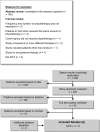Effect of Increased Intensity of Physiotherapy on Patient Outcomes After Stroke: An Evidence-Based Analysis
- PMID: 26356355
- PMCID: PMC4559318
Effect of Increased Intensity of Physiotherapy on Patient Outcomes After Stroke: An Evidence-Based Analysis
Abstract
Background: After stroke, impairment of the upper and lower limb can limit patients' motor function and ability to perform activities of daily living (ADL). Physiotherapy (PT) is an established clinical practice for stroke patients, playing an important role in improving limb function. Recently, several randomized trials have evaluated the effect of higher-intensity physiotherapy (increased duration and/or frequency) on patients' functional ability.
Objectives: Our objective is to investigate whether an increased intensity of PT after stroke results in better outcomes for patients.
Data sources: A literature search was performed on June 7, 2013, for English-language randomized controlled trials published from January 1, 2003, to June 7, 2013. Ovid MEDLINE, Ovid MEDLINE In-Process and Other Non-Indexed Citations, Ovid Embase, EBSCO Cumulative Index to Nursing & Allied Health Literature (CINAHL), and EBM Reviews were searched.
Review methods: We reviewed the full text of articles that compared 2 or more levels of PT intensity. Outcomes of interest included motor function, ADL, and quality of life (QOL).
Results: High-quality evidence showed that higher-intensity upper-limb PT and higher-intensity lower-limb PT both resulted in significantly greater improvements in motor function. Moderate-quality evidence showed that higher-intensity general PT did not. Moderate-quality evidence showed a significant improvement in ADL performance with higher-intensity upper-limb PT, but no improvement with higher-intensity general PT; no studies reported on ADL outcomes on lower-limb PT specifically. According to moderate-quality evidence, patient QOL did not change significantly after increased intensity of upper-limb, lower-limb, or general PT. When considering the results, one difference should be noted: Compared with the studies examining upper- and lower-limb PT, the studies examining general PT looked at a smaller increase-2 hours or less of additional therapy per week.
Limitations: This analysis is limited to the earlier post-stroke phase and is not equipped to comment on expected outcomes of later-stage PT.
Conclusions: Overall, this analysis found support for the use of more intensive PT to improve motor function and ability to perform ADL after stroke.
Figures










References
-
- Duncan PW, Goldstein LB, Horner RD, Landsman PB, Samsa GP, Matchar DB. Similar motor recovery of upper and lower extremities after stroke. Stroke. 1994. Jun; 25(6): 1181–8. - PubMed
-
- Friedman PJ. Gait recovery after hemiplegic stroke. Int Disabil Stud. 1990. Jul; 12(3): 119–22. - PubMed
-
- Kwakkel G, Wagenaar RC, Twisk JW, Lankhorst GJ, Koetsier JC. Intensity of leg and arm training after primary middle-cerebral-artery stroke: a randomised trial. Lancet. 1999. Jul 17; 354(9174): 191–6. - PubMed
-
- Winstein CJ, Rose DK, Tan SM, Lewthwaite R, Chui HC, Azen SP. A randomized controlled comparison of upper-extremity rehabilitation strategies in acute stroke: a pilot study of immediate and long-term outcomes. Arch Phys Med Rehabil. 2004; 85(4): 620–8. - PubMed
-
- Barker RN, Brauer SG. Upper limb recovery after stroke: the stroke survivors' perspective. Disabil Rehabil. 2005. Oct 30; 27(20): 1213–23. - PubMed
Publication types
MeSH terms
LinkOut - more resources
Full Text Sources
Medical
